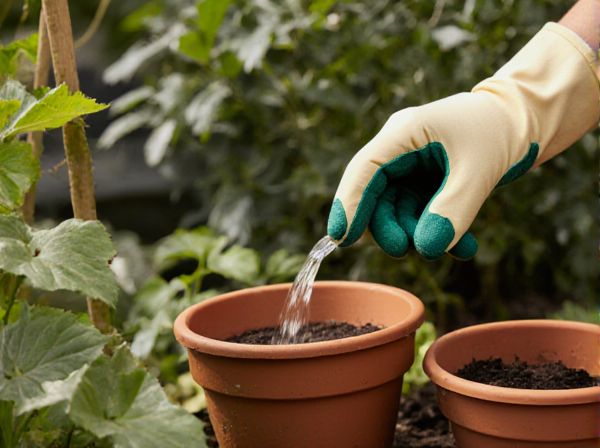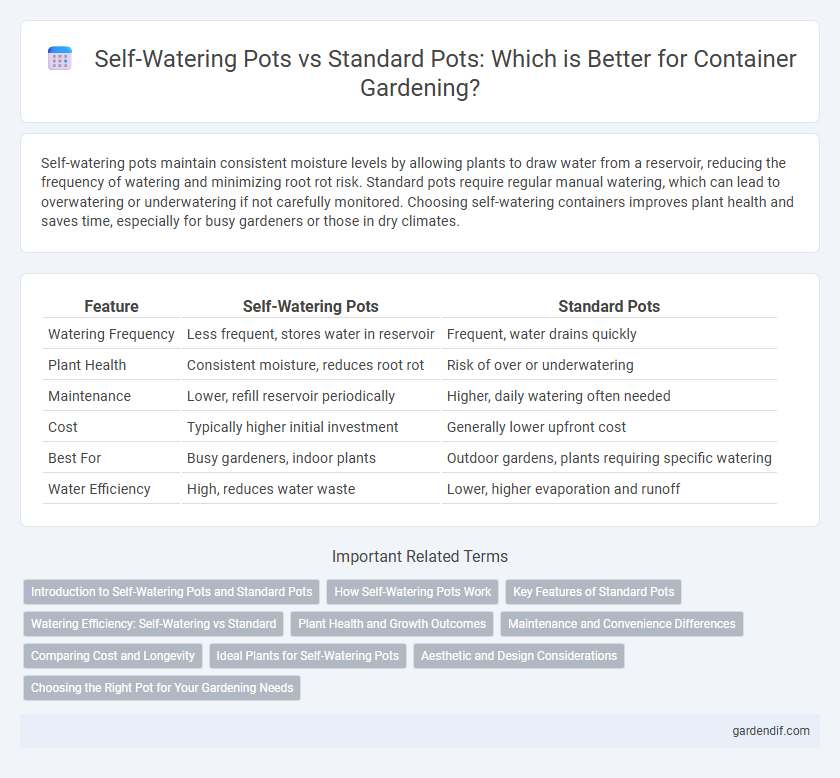
Self-watering pots vs standard pots Illustration
Self-watering pots maintain consistent moisture levels by allowing plants to draw water from a reservoir, reducing the frequency of watering and minimizing root rot risk. Standard pots require regular manual watering, which can lead to overwatering or underwatering if not carefully monitored. Choosing self-watering containers improves plant health and saves time, especially for busy gardeners or those in dry climates.
Table of Comparison
| Feature | Self-Watering Pots | Standard Pots |
|---|---|---|
| Watering Frequency | Less frequent, stores water in reservoir | Frequent, water drains quickly |
| Plant Health | Consistent moisture, reduces root rot | Risk of over or underwatering |
| Maintenance | Lower, refill reservoir periodically | Higher, daily watering often needed |
| Cost | Typically higher initial investment | Generally lower upfront cost |
| Best For | Busy gardeners, indoor plants | Outdoor gardens, plants requiring specific watering |
| Water Efficiency | High, reduces water waste | Lower, higher evaporation and runoff |
Introduction to Self-Watering Pots and Standard Pots
Self-watering pots feature an integrated reservoir that supplies consistent moisture directly to plant roots, reducing the frequency of watering and preventing overwatering. Standard pots rely on manual watering with drainage holes allowing excess water to escape, which can lead to either underwatering or root rot if not monitored closely. The choice between self-watering and standard pots significantly affects plant hydration management and overall growth success.
How Self-Watering Pots Work
Self-watering pots feature a built-in reservoir that supplies water to plants through capillary action or a wicking system, ensuring consistent moisture levels in the soil. This mechanism reduces the risk of overwatering and underwatering by allowing plants to absorb water as needed, promoting healthier root development. Standard pots lack this water reservoir, requiring frequent manual watering and closer monitoring of soil moisture.
Key Features of Standard Pots
Standard pots are typically made from materials such as plastic, clay, or ceramic, offering durability and a variety of sizes and styles. These containers require manual watering, allowing gardeners full control over moisture levels and the frequency of irrigation. Their simplicity and affordability make them a popular choice for both indoor and outdoor planting, though they may need consistent monitoring to prevent over- or under-watering.
Watering Efficiency: Self-Watering vs Standard
Self-watering pots improve watering efficiency by providing a consistent moisture supply through a built-in reservoir that reduces water waste and prevents overwatering. Standard pots rely on manual watering, which often leads to uneven moisture levels and increased evaporation. This difference makes self-watering pots ideal for maintaining optimal hydration and promoting healthier root development in container gardening.
Plant Health and Growth Outcomes
Self-watering pots maintain consistent soil moisture by regulating water supply, reducing the risk of underwatering or overwatering that can stress plants and stunt growth. Standard pots require frequent manual watering, which may lead to uneven moisture levels, potentially causing root damage or nutrient deficiencies. Studies show plants in self-watering pots generally exhibit stronger root development, higher photosynthesis rates, and increased overall biomass compared to those in standard containers.
Maintenance and Convenience Differences
Self-watering pots significantly reduce maintenance by providing a consistent water supply through an internal reservoir, minimizing the frequency of watering and preventing overwatering or underwatering. In contrast, standard pots require more frequent manual watering and careful monitoring of soil moisture to avoid plant stress. Self-watering containers enhance convenience for busy gardeners or those with limited access to daily plant care, making them ideal for indoor and outdoor gardening alike.
Comparing Cost and Longevity
Self-watering pots typically have a higher upfront cost than standard pots due to built-in reservoirs and wicking systems, but they reduce water usage and plant maintenance over time. Standard pots are less expensive initially but may require frequent watering and potentially more replacements due to wear or plant health issues. Long-term savings with self-watering pots come from improved plant growth, water conservation, and fewer replacements, making them cost-effective despite the initial investment.
Ideal Plants for Self-Watering Pots
Self-watering pots are ideal for moisture-loving plants such as ferns, peace lilies, and herbs like basil and mint, which require consistent hydration to thrive. These pots provide a controlled water supply, reducing the risk of over- or under-watering common in standard pots. Succulents and cacti are less suited for self-watering containers due to their preference for dry soil conditions.
Aesthetic and Design Considerations
Self-watering pots showcase sleek, modern designs that integrate water reservoirs discreetly, enhancing aesthetic appeal while minimizing mess. Standard pots offer diverse styles, materials, and finishes, allowing for personalized decoration but often require saucers to catch excess water, which can detract from visual harmony. The clean lines and practical innovation of self-watering containers appeal to minimalistic and functional design preferences.
Choosing the Right Pot for Your Gardening Needs
Self-watering pots feature built-in reservoirs that provide consistent moisture, reducing the frequency of watering and promoting healthier root growth, ideal for busy gardeners or plants requiring steady hydration. Standard pots, usually made of terracotta, plastic, or ceramic, offer greater airflow and better drainage, making them suitable for plants prone to root rot or those needing drier soil conditions. Selecting the right pot depends on your plant species, watering habits, and environmental conditions to optimize growth and maintenance efficiency.
Self-watering pots vs standard pots Infographic

 gardendif.com
gardendif.com